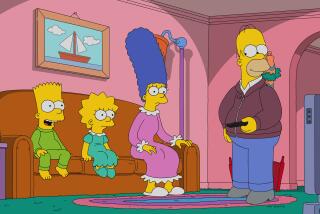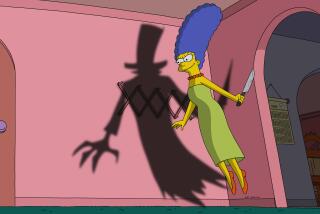D’oh! Homer Simpson beat scientists in race to find Higgs boson mass
Does Homer Simpson deserve a share of the 2013 Nobel Prize in physics? Did the European Organization for Nuclear Research and its scientific partners waste $10 billion constructing the Large Hadron Collider?
In short, could particle physicists have saved themselves a lot of trouble and simply watched a 1998 episode of “The Simpsons” to figure out the mass of the Higgs boson?
In the episode, titled “The Wizard of Evergreen Terrace,” a mid-life crisis inspires Homer to become an inventor in the mold of Thomas Edison. One scene features him at a blackboard working on an equation to calculate the mass of a Higgs boson, the elusive subatomic particle that is key to understanding why objects in the universe have mass in the first place. (You can see a picture of the blackboard here.)
Simon Singh, a science writer with a doctorate in particle physics, crunched Homer’s numbers and declared that the usually hapless Homer got his math pretty much right.
“That equation predicts the mass of the Higgs boson” Singh told the Independent. “If you work it out, you get the mass of a Higgs boson that’s only a bit larger than the nano-mass of a Higgs boson actually is. It’s kind of amazing as Homer makes this prediction 14 years before it was discovered.”
Well, not exactly.
According to David Kaplan, a bona fide particle physicist at Johns Hopkins University, Homer’s equation yields a value of 777 gigaelectronvolts, or GeV. The actual value measured at the Large Hadron Collider is more like 125 GeV, plus or minus a GeV.
“It is a bit off, but not insanely so,” Kaplan said.
And it was almost a whole lot closer to the truth. The final term in Homer’s equation is the square root of “hc” divided by “G.” Presumably, “G” is the universal gravitational constant, “c” is the speed of light, and “h” is Planck’s constant. If Homer had used a variant called the reduced Planck’s constant (which divides “h” by 2 pi), the answer to the equation would have been about 310 GeV, Kaplan said.
Homer would have done even better if he hadn’t made pi the first term in his equation, Kaplan added. Without it, he’d have had “a nice guess of 99 GeV, which would not have been too shabby,” he said.
Even so, 777 GeV was not outside the realm of possibility back in 1998 – at that time, the upper limit was thought to be around 850 GeV. Still, those in the know were already seeing evidence that the true mass of the Higgs was significantly lower, Kaplan explained.
Unfortunately, the other equations on Homer’s blackboard aren’t quite as close to reality.
Although the second equation is made up entirely of actual numbers, it “appears to violate Fermat’s last theorem,” Kaplan said. That theorem states that in the equation xn + yn = zn, “n” cannot be any whole number greater than 2.
The third line is a mathematical way of saying that the universe is closed, which could mean that everything ends in a “big crunch” (although we might avert this fate if there’s enough dark energy around). In reality, scientists believe the universe is not closed but flat.
The fourth line appears to show how a doughnut can evolve into a spherical body that vaguely resembles the moon.
“The whole board is great,” Kaplan said.
However you judge the accuracy of Homer’s Higgs boson prediction, it is certainly true that “The Simpsons” makes sophisticated references to scientific concepts. Singh has written a whole book on the subject (“The Simpsons and their Mathematical Secrets.”) There’s also “What’s Science Ever Done for Us? What the Simpsons Can Teach Us About Physics, Robots, Life, and the Universe” by Paul Halpern, a physics professor at the University of the Sciences in Philadelphia.
If you want to watch a truly awesome show about the Higgs boson, check out “Particle Fever,” Kaplan’s documentary that takes viewers behind the scenes in the hunt for the Higgs boson.
Who says science isn’t entertaining? Not me! Follow me on Twitter @LATkarenkaplan and “like” Los Angeles Times Science & Health on Facebook.







